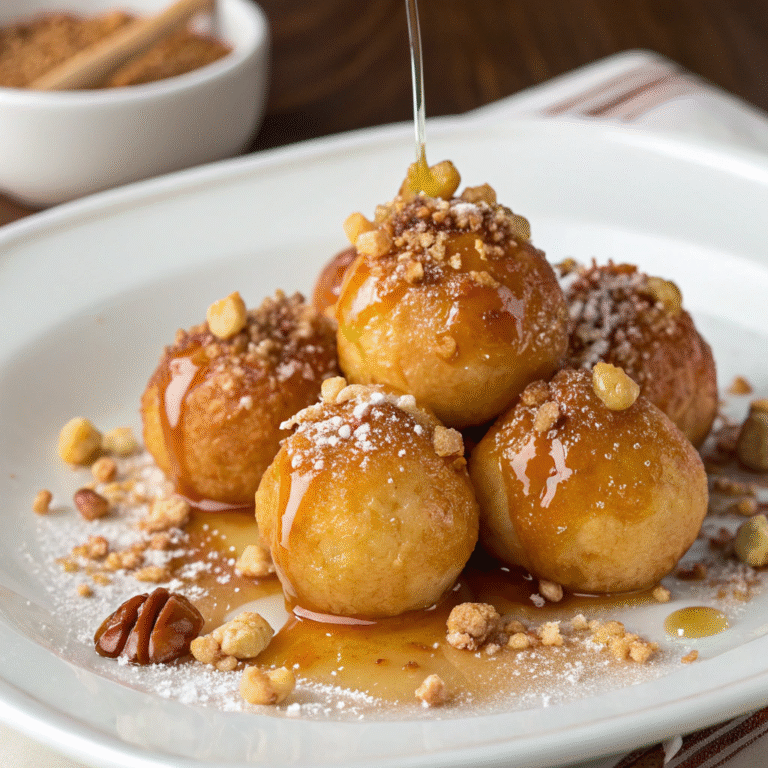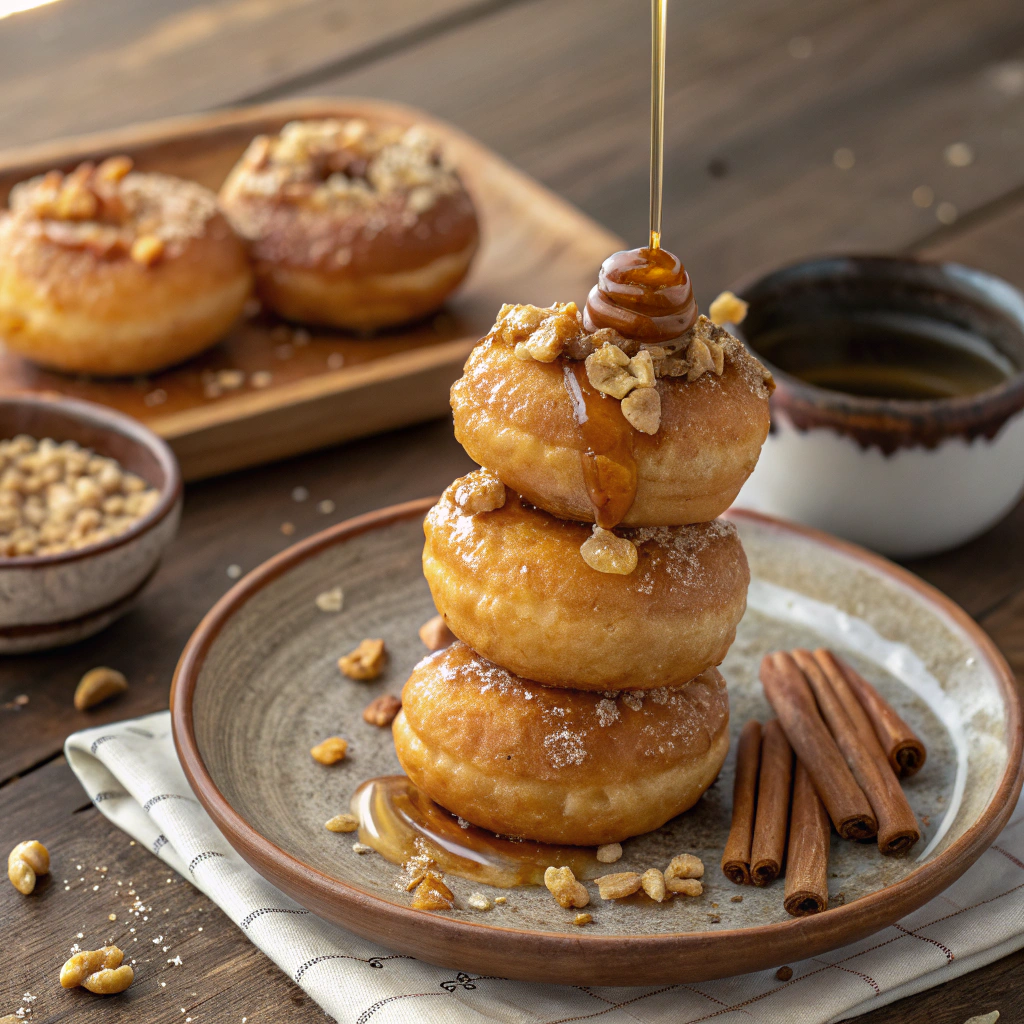Greek donuts with honey, better known as loukoumades, are an iconic dessert that dates back to ancient Greece. These golden, crispy-on-the-outside, soft-on-the-inside pastries are soaked in fragrant honey syrup and often topped with crushed nuts or cinnamon. In this article, we’ll explore everything about these indulgent treats—from their rich history and traditional recipes to modern twists and health-friendly versions. You’ll also discover how they’re served, why Greek honey is key, and the difference between loukoumades and their Turkish cousin, lokma.
Looking for inspiration? Try our post on Greek honey donuts—it pairs perfectly with this read!
Table of Contents
Table of Contents
Introduction to Greek Donuts with Honey
What Makes Greek Donuts with Honey So Special?
Greek donuts with honey aren’t your everyday pastry. These doughy bites are deeply embedded in Greek tradition and are often the centerpiece of religious feasts, family gatherings, and even ancient Olympic celebrations. Their unique texture—crispy shell with a fluffy interior—combined with the sweetness of Greek honey and a hint of spice, makes them utterly irresistible. Unlike other donuts, loukoumades aren’t glazed or filled. Instead, they soak up a golden honey syrup that gives them their iconic taste and sheen.
These donuts aren’t just food—they’re an experience. They’re typically made fresh, served warm, and devoured quickly, making them a staple street food as well as a celebratory dish.
A Brief History of Loukoumades and Their Greek Roots
Loukoumades are considered one of the oldest recorded desserts in the world. According to historical texts, they were served to victors at the first Olympic Games in 776 BC as “honey tokens.” That’s right—these ancient honey-soaked fritters have been satisfying sweet cravings for over 2,000 years!
The name “loukoumades” comes from the Arabic word luqma, meaning “morsel” or “bite.” Despite their Arabic-Turkish linguistic connection, loukoumades have solid roots in Greek culinary tradition and are distinctly Greek in their preparation and cultural significance.
Throughout history, different Greek islands and regions have developed their own variations of loukoumades, some using sesame, others flavored with orange or mastiha. Today, they’re still very much alive in both traditional and modern Greek kitchens.
Traditional Recipe for Greek Donuts with Honey
Ingredients You’ll Need for Authentic Loukoumades
Making authentic Greek donuts with honey at home is easier than you might think. The dough is simple and made from pantry staples, yet when fried and soaked in syrup, it transforms into a dessert that tastes like it came straight from a Greek festival.
Here’s what you’ll need:
| Ingredient | Quantity | Purpose |
|---|---|---|
| All-purpose flour | 2 cups | Forms the base of the dough |
| Warm water | 1½ cups | Activates the yeast |
| Instant yeast | 2¼ teaspoons (1 packet) | Leavens the dough |
| Sugar | 1 tablespoon | Feeds the yeast |
| Salt | ½ teaspoon | Enhances the flavor |
| Cornstarch (optional) | 1 tablespoon | Makes them crispier |
| Olive oil | 1 tablespoon | Adds richness |
| Vegetable oil (for frying) | Enough to deep fry | Used for frying the dough balls |
For the honey syrup:
- ½ cup Greek honey
- ¼ cup water
- 1 tablespoon sugar
- 1 cinnamon stick
- Lemon zest or a dash of lemon juice (optional)
Optional toppings:
- Crushed walnuts or pistachios
- Ground cinnamon
- Powdered sugar
Step-by-Step Instructions to Make Perfect Greek Honey Donuts

1. Make the Dough
In a large bowl, whisk together the warm water, yeast, and sugar. Let the mixture sit for about 10 minutes until it starts to foam—this means your yeast is active.
Add flour, salt, and olive oil to the yeast mixture. Mix with a wooden spoon or spatula until you get a sticky, elastic dough. If you like crispier loukoumades, toss in that tablespoon of cornstarch.
Cover the bowl with a clean towel and let the dough rise in a warm place for about 1 to 1.5 hours, or until it doubles in size.
2. Prepare the Honey Syrup
While the dough rises, prepare your honey syrup. Combine honey, water, sugar, and the cinnamon stick in a saucepan. Simmer over medium heat for 10–12 minutes. Add lemon zest or a splash of lemon juice at the end for a subtle zing. Remove from heat and keep warm.
3. Fry the Dough Balls
In a deep pot, heat vegetable oil to 350°F (175°C). Dip a teaspoon into cold water (to prevent sticking), scoop small portions of dough, and carefully drop them into the hot oil. Fry in batches to avoid crowding.
Turn the donuts often for even cooking. When they’re golden brown and puffed up (about 3-4 minutes), remove with a slotted spoon and drain on paper towels.
4. Soak and Serve
While still warm, drop the donuts into the warm honey syrup. Let them soak for about 30 seconds, then transfer to a serving plate.
Top with crushed nuts, a dash of cinnamon, or powdered sugar—and enjoy!
These steps result in the most authentic loukoumades—crispy outside, airy inside, and dripping with sweet, floral Greek honey.
Discover great ideas like our Frozen Greek Yogurt Dessert Recipes for a perfect pairing with loukoumades.
Variations and Regional Twists
Unique Greek Regional Variants of Loukoumades
Although the classic Greek donuts with honey recipe is beloved across Greece, various regions have put their own twist on this ancient dessert, adapting the recipe with local ingredients and traditional methods.
1. Loukoumades of Crete
In Crete, these donuts are often served with a generous drizzle of thyme honey, which is native to the island and known for its intense aroma and flavor. Cretan variations may also include sesame seeds and local cheeses, giving the dish a savory-sweet twist.
2. Santorini’s Donuts with Wine
On Santorini, the local take incorporates vin santo wine or red wine into the dough, adding depth and a subtle tanginess to the flavor. These wine-infused loukoumades are usually topped with honey syrup and lightly crushed almonds.
3. Loukoumades of Cyprus
While not a Greek island per se, Cyprus offers a popular variation called lokmades—a nod to the Turkish influence. These are slightly smaller, crispier, and often include anise in the dough. They’re dunked in syrup made from honey and rose water.
4. Loukoumades me Mastiha
In Northern Greece, you’ll often find loukoumades flavored with mastiha, a resin collected from the mastic tree native to Chios Island. This ingredient gives the donuts a unique pine-like, herbal note that sets them apart.
These regional touches create subtle flavor differences while still preserving the dessert’s classic soul—crispy, golden dough kissed with honey.
Modern Takes: Vegan, Gluten-Free, and Dairy-Free Loukoumades
Craving loukoumades but need a version that fits your lifestyle? Thankfully, modern food lovers have developed innovative adaptations of Greek donuts with honey to suit every diet.
1. Vegan Loukoumades
Traditional loukoumades are naturally dairy-free, but to ensure they’re completely vegan:
- Replace honey with agave nectar or maple syrup.
- Use plant-based oil (like avocado or canola) for frying.
The result? Still crispy, fluffy, and delicious—just without animal byproducts.
2. Gluten-Free Loukoumades
To make your loukoumades gluten-free:
- Use a 1:1 gluten-free flour blend.
- Add ½ teaspoon of xanthan gum if your flour doesn’t contain it.
- Consider a mix of rice flour and cornstarch for extra crispness.
The dough will be slightly different in texture, but with proper frying, they’ll be just as satisfying.
3. Health-Conscious Modifications
Trying to reduce sugar or calories?
- Replace white sugar with coconut sugar or stevia in the syrup.
- Air-fry small dough balls using a well-greased air fryer basket instead of deep frying.
- Add mashed banana or pumpkin puree to the dough for sweetness and fiber.
No matter your dietary needs, there’s a loukoumades recipe for you.
Check out more on Greek food recipes with easy desserts—ideal for those craving variety!
Print
Traditional Greek Donuts with Honey (Loukoumades)
Golden, crispy Greek donuts soaked in warm honey syrup—an authentic loukoumades recipe.
- Total Time: 1 hour 45 minutes
- Yield: 24 donuts
Ingredients
2¼ teaspoons instant yeast
1 tablespoon sugar
1¾ cups lukewarm water
2 cups all-purpose flour
2 tablespoons cornstarch (optional, for crispiness)
Pinch of salt
1 tablespoon olive oil
Neutral oil for frying (vegetable, canola, or sunflower)
—For the Honey Syrup—
½ cup Greek honey
2 tablespoons water
1 teaspoon fresh lemon juice
(Optional) 1 teaspoon orange blossom water or rose water
—Toppings—
Ground cinnamon
Chopped walnuts or pistachios
Powdered sugar (optional)
Instructions
In a large bowl, mix the yeast, sugar, and lukewarm water. Let the mixture sit for 5–10 minutes until it becomes foamy.
Add the flour, cornstarch (if using), salt, and olive oil. Stir until a sticky, smooth dough forms.
Cover the bowl with a towel or plastic wrap and let the dough rise in a warm place until doubled in size and bubbly, about 1 to 1½ hours.
Heat 2–3 inches of neutral oil in a deep pot to 360–375°F (182–190°C). Prepare a small bowl of water to dip your spoon or fingers in to prevent sticking.
Using a wet spoon or your fingers, scoop small portions of dough and drop them gently into the hot oil. Fry the dough balls in batches to avoid overcrowding.
Turn the donuts frequently and fry for about 2–3 minutes until they’re golden brown and puffed. Remove with a slotted spoon and drain on paper towels.
While frying, prepare the honey syrup by warming the honey, water, and lemon juice in a small saucepan over low heat. Stir gently until it becomes slightly thickened and syrupy.
Optional: Add orange blossom water or rose water for a floral aroma. Keep the syrup warm.
Place the warm donuts in the honey syrup and toss gently to coat, or drizzle the syrup over them while plating.
Garnish with cinnamon and chopped nuts. Serve immediately while hot and crispy.
Notes
Make sure your oil stays between 360°F and 375°F—too hot and the loukoumades will brown too fast; too cool and they’ll turn out greasy.
For a floral, Mediterranean twist, try adding a splash of orange blossom water or rose water to your honey syrup.
Loukoumades are best served immediately after soaking in the syrup while they’re still warm and crispy.
To prep ahead, you can make the dough and refrigerate it for up to 24 hours before frying.
If you prefer less sweetness, drizzle the syrup lightly instead of soaking the donuts.
Top with crushed pistachios, walnuts, or sesame seeds for extra crunch and flavor.
These Greek donuts with honey make a fantastic dessert for parties, name days, or any celebration tied to Greek traditions.
Leftovers? Reheat loukoumades in the oven at 350°F for 5–6 minutes to crisp them up again—avoid the microwave!
You can use agave nectar or maple syrup as a vegan alternative to Greek honey.
- Prep Time: 15 minutes
- Cook Time: 15 minutes
- Category: Greek Desserts
- Method: Frying
- Cuisine: Greek
- Diet: Vegetarian
Greek Honey and Its Role in Loukoumades
Why Greek Honey Is the Secret Ingredient
When it comes to crafting the perfect Greek donuts with honey, the star isn’t just the dough—it’s the honey. Not all honey is created equal, and Greek honey stands out as one of the most flavorful and nutrient-rich in the world.
Greek honey is:
- Raw and unfiltered: It’s often minimally processed, retaining enzymes, antioxidants, and natural sugars.
- Rich in floral flavor: Thanks to Greece’s abundant wild herbs and wildflowers, the bees produce honey with distinctive layers of taste.
- Highly aromatic: The sun-drenched landscapes and variety of plants like thyme, pine, and orange blossoms give the honey a fragrant profile that enhances every bite of loukoumades.
Unlike commercial or processed honey, Greek honey offers a depth of flavor that doesn’t just sweeten—it transforms your dessert.
When poured over piping-hot loukoumades, it seeps into the golden crust, balancing the rich fried texture with a floral, citrusy, or earthy note depending on the variety.
Types of Greek Honey Used in Traditional Recipes
Different regions of Greece produce different types of honey, each adding a unique spin to traditional loukoumades. Here are some popular choices:
1. Thyme Honey (Thymari)
Originating mainly from Crete and the Cyclades, this honey is light amber, highly aromatic, and slightly peppery. It’s one of the most popular choices for loukoumades due to its ability to cut through the richness of the fried dough.
2. Pine Honey
Found primarily in northern Greece, pine honey has a deep amber color and less sweetness than floral honey. Its subtle woody flavor gives loukoumades a warm, earthy tone.
3. Orange Blossom Honey
This sweet, citrusy honey comes from the Peloponnese and other southern regions. It pairs especially well with cinnamon-topped loukoumades, offering a refreshing contrast.
4. Wildflower Honey
Also called anthi, this multifloral honey is collected from various wild plants and herbs. It’s versatile and works well in both syrups and glazes for donuts.
5. Heather Honey (Reiki)
Thicker and darker, heather honey is rich in antioxidants and has a caramel-like flavor. It adds a decadent, luxurious feel to the dessert.
If you want to recreate a true Greek experience at home, use Greek-sourced honey instead of generic supermarket brands.
Don’t miss our underrated gem: Greek yogurt chocolate—a delicious treat to pair with honey-based desserts like loukoumades.
Serving and Presentation Ideas

Classic Greek Presentation with Nuts and Cinnamon
In Greece, the way loukoumades—Greek donuts with honey—are served is just as important as how they taste. Presentation not only enhances the dessert’s visual appeal but also elevates the overall experience. Traditionally, these golden puffs are served piping hot, generously soaked in honey syrup, and sprinkled with aromatic toppings.
Here’s how they’re classically plated:
- Piled high on a shallow dish or platter, allowing excess honey to pool around the base.
- Topped with ground cinnamon, which adds a warm, spicy contrast to the sweet honey.
- Sprinkled with crushed walnuts or pistachios, giving a crunchy texture and nutty finish.
- Served with toothpicks or small forks, making them easy to pick up and enjoy communally.
For special occasions like name days or national holidays, loukoumades might even be arranged in a spiral and topped with edible gold leaf or candied orange peel for a more festive vibe.
How to Plate Loukoumades for Festive Occasions
Loukoumades make a showstopping centerpiece at parties, weddings, or family dinners when styled creatively. Here are a few festive ideas to upgrade their presentation:
1. Mini Loukoumades Towers
Stack mini-sized loukoumades into a cone shape and drizzle the honey syrup from the top, letting it trickle down. Add a cinnamon stick or rosemary sprig for garnish.
2. Greek Dessert Mezze Platter
Create a dessert board with loukoumades at the center surrounded by:
- Greek yogurt dips
- Halva slices
- Orange segments
- Dried figs or dates
- Spoon sweets (glyka tou koutaliou)
This modern twist impresses guests while staying authentic.
3. Shot Glass Servings
Place 2–3 loukoumades in a clear shot glass, drizzle honey, and sprinkle nuts. It’s an elegant way to serve them as individual portions at cocktail parties or buffets.
4. With Ice Cream
For a more indulgent version, serve loukoumades with a scoop of Greek yogurt ice cream or masticha-flavored gelato. The hot-and-cold combo is unforgettable.
Check out our twist on tradition in Simple Greek Dessert Recipes for more creative ways to serve classic sweets like these.
Presentation is key not just for the eyes, but for enhancing the texture contrast—crispy, sticky, crunchy, creamy—all in one bite.
Nutritional Facts and Healthier Alternatives
Are Greek Donuts with Honey Healthy?
Let’s be real—loukoumades, or Greek donuts with honey, are an indulgence. But does that mean they’re automatically bad for you? Not necessarily. Like any dessert, moderation is key.
Here’s a nutritional snapshot for 5 medium-sized loukoumades (without toppings):
| Nutrient | Amount |
|---|---|
| Calories | ~300–350 kcal |
| Total Fat | 18–22g |
| Saturated Fat | 2–4g |
| Carbohydrates | 35–40g |
| Sugars | 15–18g |
| Protein | 3–5g |
| Fiber | <1g |
These values can vary based on the frying oil, flour type, and the quantity of honey used. The bulk of calories comes from frying and the sweet syrup. Still, when enjoyed occasionally and served in small portions, they can absolutely be part of a balanced diet.
But what if you want to enjoy loukoumades more often—without the guilt? That’s where healthier alternatives come in.
Smart Substitutions to Lighten Up the Recipe
Craving Greek donuts with honey but aiming for something less calorie-dense? Here are practical ways to keep the flavor while trimming the fat and sugar:
1. Air-Fry Instead of Deep-Fry
- Coat your air fryer basket lightly with oil spray.
- Spoon in small balls of dough and air-fry at 375°F for 10–12 minutes.
- Results: slightly crispier exterior but significantly lower in fat.
2. Use Whole Wheat or Oat Flour
- Substitute half of the all-purpose flour with whole wheat or oat flour to add fiber and nutrients.
- Expect a denser texture, but more complex flavor and added satiety.
3. Reduce Sugar in the Syrup
- Replace half of the sugar in the syrup with stevia or monk fruit sweetener.
- Or use only natural honey without adding extra sugar to the syrup mixture.
4. Add Superfoods
- Sprinkle chia seeds or flax seeds into the dough for omega-3s.
- Top with crushed almonds instead of sugar-dense glazes.
5. Control the Portions
- Make mini loukoumades, about the size of a cherry tomato. You’ll enjoy the same taste in fewer bites.
Even with changes, these healthified loukoumades still deliver on crunch, sweetness, and traditional flavor.
Don’t miss our clean twists in Greek yogurt dessert recipes—perfect for those who want something sweet yet wholesome.
Cultural Significance and Occasions

Loukoumades in Greek Celebrations and Holidays
In Greece, food isn’t just nourishment—it’s tradition, emotion, and storytelling. Greek donuts with honey, or loukoumades, have been enjoyed across generations during holidays, religious feasts, and life milestones. Their golden color and sweet flavor symbolize blessing, abundance, and festivity.
Here are some key cultural moments where loukoumades take center stage:
1. Greek Name Days and Birthdays
Unlike many cultures that focus primarily on birthdays, Greeks celebrate name days—feasts tied to saints. It’s common to serve loukoumades to guests as a sweet treat of celebration and hospitality.
2. Orthodox Holidays
During Feast Days like the Assumption of the Virgin Mary or Epiphany, families gather and share traditional foods. Loukoumades, drizzled in honey and dusted with cinnamon, are often part of the festive spread.
3. Weddings and Baptisms
Loukoumades are considered lucky sweets. Couples might include them in dessert buffets during weddings or as part of “kerasma” (a treat offered to guests at religious celebrations like baptisms or communions).
4. Street Festivals and Panigiria
At panigiria (village fairs), loukoumades vendors are a staple. They serve piping-hot donuts fresh from the fryer, drenched in local honey and often topped with walnuts. The smell alone draws long lines.
Loukoumades aren’t just a dessert—they’re part of how Greeks express love, community, and celebration.
Mythological and Religious Connections of Honey Donuts in Greece
1. Ties to Ancient Greece and the Olympics
Loukoumades are widely believed to be the first-ever recorded Olympic “medal.” At the ancient Olympic Games in 776 BC, victors were reportedly awarded “honey tokens”—fried dough soaked in honey. These tokens were symbolic gifts to the gods, especially Zeus, as part of ritual offerings.
The connection between loukoumades and victory has endured, making the dessert a symbol of excellence and honor.
2. Symbol of Sweetness and Light in Religion
In Greek Orthodox tradition, honey represents divine grace, abundance, and purity. That’s why loukoumades often appear during religious festivals—they’re not just tasty, they carry spiritual symbolism.
Some believe the round shape of loukoumades reflects eternity and wholeness, a nod to life cycles and blessings.
3. Folk Beliefs and Superstitions
In some Greek villages, it’s customary to make loukoumades during the first full moon of the year to attract good fortune. Others believe offering loukoumades to guests brings prosperity and protection to the home.
So yes, every bite of this golden, sticky dessert is steeped in centuries of cultural richness.
Don’t miss our heritage-rich guide on Greek dessert recipe—packed with sweets that tell a story, just like loukoumades.
Loukoumades vs Lokma – Know the Difference
What Is the Difference Between Loukoumades and Lokma?
Greek donuts with honey, known as loukoumades, share striking similarities with a Turkish dessert called lokma. Both are fried dough balls soaked in syrup or honey, but despite the visual resemblance, the two are not the same—they have different origins, textures, and flavor profiles.
Here’s a breakdown of their key differences:
| Feature | Loukoumades (Greek) | Lokma (Turkish) |
|---|---|---|
| Syrup Base | Greek honey (often with cinnamon) | Sugar syrup (lemony or floral) |
| Flavor | Rich, floral, and spiced | Sweeter, lighter, less complex |
| Texture | Fluffy inside, crisp outside | Often more crunchy, smaller interior |
| Toppings | Nuts, cinnamon, sesame, powdered sugar | Generally plain or with sesame |
| Serving Style | Festive, plated for sharing | Often street-style in disposable cups |
| Cultural Roots | Ancient Greece – Olympic “honey tokens” | Ottoman Empire and Islamic traditions |
So while both are delightful fried desserts, loukoumades are known for their flavor complexity and cultural depth, while lokma is appreciated for its simplicity and crunchy bite.
Regional Preferences: Greek vs Turkish Donut Balls
In Greece: Loukoumades Are Sacred
Loukoumades are more than just a dessert—they’re tied to religion, mythology, and celebration. You’ll find them at church feasts, birthdays, and festivals, always garnished with Greek honey, cinnamon, and crushed nuts. The goal isn’t just sweetness—it’s balance and tradition.
In Turkey: Lokma Is a Symbol of Remembrance
Lokma is often made to honor the deceased or commemorate anniversaries. Locals may offer it to neighbors or strangers with the phrase “May God accept it.” It’s also a popular street food, commonly served fresh in public squares and busy markets.
Shared Roots, Separate Paths
Both desserts may trace back to the Eastern Mediterranean, but they evolved in distinct culinary directions. Over time, each culture gave their version a unique twist—loukoumades becoming richer and ceremonial, and lokma becoming leaner and more casual.
Learn more about other classic Greek food dessert traditions that make Greece a
FAQ About Greek Donuts with Honey
In this section, we’ll tackle the most frequently asked questions about loukoumades—aka Greek donuts with honey. Whether you’re new to them or a devoted fan, these answers will help you appreciate this ancient dessert even more.paradise for sweet lovers.
What are loukoumades made of?
Loukoumades are made from a simple yeast-leavened dough that includes flour, water, yeast, sugar, and a pinch of salt. After the dough rises, it’s deep-fried until golden and puffy, then soaked in Greek honey syrup and topped with cinnamon or crushed nuts.
Some regional recipes add ingredients like olive oil, cornstarch, or orange zest for texture and aroma. The dough is soft and elastic before frying and becomes airy inside and crisp outside when cooked.
What are Greek honey balls called?
Greek honey balls are called loukoumades. In some English-speaking regions, people casually refer to them as “Greek honey puffs” or “Greek donuts,” but in Greece, they are lovingly known by their traditional name.
The word loukoumades likely derives from the Arabic luqma, meaning “bite” or “morsel,” though the dessert itself has been a part of Greek culture for centuries, with roots dating back to the first Olympic Games.
What are Greek honey puffs made of?
Greek honey puffs—another name for loukoumades—are made of:
All-purpose flour
Warm water
Yeast
Sugar
Salt
Olive oil (optional)
They’re fried in oil and then drenched in a warm honey syrup that may include cinnamon or lemon zest. Finally, they’re topped with optional nuts, sesame seeds, or powdered sugar for added flavor and texture.
What do loukoumades taste like?
Loukoumades taste crispy, fluffy, sweet, and spiced—all in one bite. The dough itself is light and airy, similar to a beignet or yeast donut. When soaked in Greek honey, the outer layer becomes sticky and fragrant, while the inside stays pillowy soft.
The added cinnamon and crushed nuts give them a warming and nutty flavor, making each bite both indulgent and balanced. If you’re lucky enough to eat them fresh out of the fryer, the taste is truly unforgettable.
What are the famous Greek donuts?
The most famous Greek donuts are loukoumades. They’re often featured in:
Street fairs and festivals
Religious holidays and name days
Traditional dessert menus
Loukoumades are beloved for their historical roots, simplicity, and addictive flavor. While other Greek sweets like baklava and galaktoboureko are well-known, loukoumades hold a unique place in Greek hearts because of their deep ties to ancient culture.
What is the difference between lokma and loukoumades?
The main difference is cultural and flavor-based:
Loukoumades: Greek origin, usually larger, topped with Greek honey, cinnamon, and nuts. Fluffy inside, crisp outside.
Lokma: Turkish version, smaller, soaked in plain sugar syrup, and often crunchier. Typically served during public events or memorials.
While they share similar ingredients and methods, the flavor profiles, toppings, and symbolic meanings are distinct in each culture.
Looking for more heritage-rich inspiration? Discover our Greek yogurt dessert recipes for delicious ideas beyond donuts.
CONCLUSION: Why You Need to Try Greek Donuts with Honey Today
Greek donuts with honey—loukoumades—are more than just a dessert. They’re a bridge between ancient tradition and modern indulgence. With their golden crunch, warm honey drizzle, and aromatic toppings, loukoumades deliver a flavor experience that’s both nostalgic and unforgettable.
From the Olympic arenas of ancient Greece to street fairs in modern Athens, loukoumades have stood the test of time. They represent celebration, victory, and sweet moments shared among family and friends. Whether you’re sticking to the classic recipe or experimenting with gluten-free, vegan, or air-fried variations, this treat is versatile and soul-satisfying.
We’ve explored their history, learned to make them from scratch, discovered how to lighten them up, and even understood their role in religious and cultural celebrations. If you’ve never tried them, now is the perfect time to bring a piece of Greece into your kitchen.
Don’t miss our flavorful guide to Greek dessert recipe for even more authentic sweets worth savoring.

